| Article ID | Journal | Published Year | Pages | File Type |
|---|---|---|---|---|
| 6760195 | Nuclear Engineering and Design | 2016 | 8 Pages |
Abstract
The ex-vessel core catcher of the PECS (Passive Ex-vessel corium retaining and Cooling System) is installed to retain and cool down the corium in the reactor cavity of the EU (European Union)-APR (Advanced Power Reactor) 1400. A verification experiment on the cooling capability of the PECS has been conducted in the CE (Cooling Experiment)-PECS. Simulations of a two-phase natural circulation flow using the RELAP5/MOD3 computer code in the CE-PECS and PECS have been conducted to predict the two-phase flow characteristics, to determine the natural circulation mass flow rate in the cooling channel, and to evaluate the scaling in the experimental design of the CE-PECS. Particularly from a comparative study of the prototype PECS and the scaled test facility of the CE-PECS, the orifice loss coefficient in the CE-PECS was found to be 6 to maintain the coolant circulation mass flux, which is approximately 273.1Â kg/m2Â s. The RELAP5 results on the coolant circulation mass flow rate are very similar to the CE-PECS experimental results. An increase in the coolant injection temperature and the heat flux lead to an increase in the coolant circulation mass flow rate. In the base case simulation, a lot of vapor was injected into the downcomer, which leads to an instability of the two-phase natural circulation flow. A super-step design at a downcomer inlet is suitable to prevent vapor injection into the downcomer piping.
Related Topics
Physical Sciences and Engineering
Energy
Energy Engineering and Power Technology
Authors
Rae-Joon Park, Kwang-Soon Ha, Bo-Wook Rhee, Hwan Yeol Kim,
